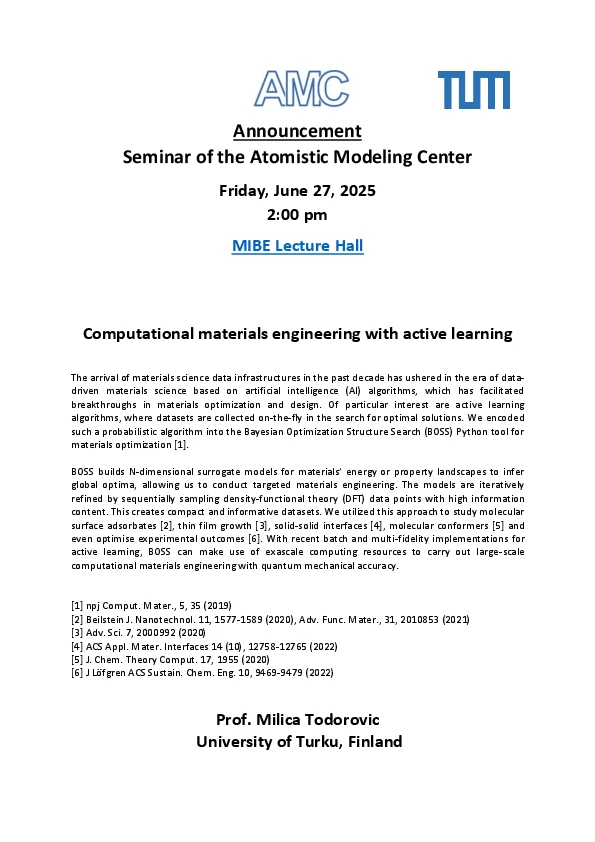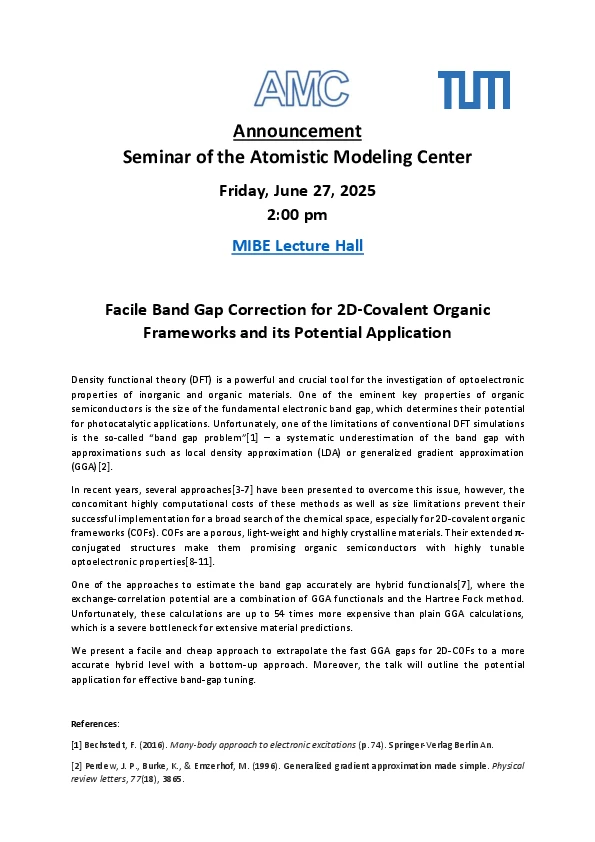AMC is organizing a Seminar Afternoon on Atomistic Modeling!
Milica Todorović is an Associate Professor in Materials Engineering at the Department of Mechanical and Materials Engineering, University of Turku, Finland. She leads the Materials Informatics Laboratory at UTU, where they integrate artificial intelligence algorithms and first-principles simulations to accelerate the discovery and optimization of functional materials across diverse fields, from aerosol research to chemical engineering of bio-based materials.
Torodovićs group encoded a probabilistic algorithm into the Bayesian Optimization Structure Search (BOSS) Python tool. In her talk on “Computational materials engineering with active learning”, she will explain how that leverages active learning and Bayesian optimization to efficiently explore materials' energy landscapes using DFT simulations, enabling data-driven and quantum-accurate materials engineering across diverse applications—from surface science to experimental optimization.
Laura Fuchs is PhD student in the group of Prof. Frank Ortmann.
She will highlight in her talk on “Facile Band Gap Correction for 2D-Covalent Organic Frameworks and its Potential Application”, that the density functional theory (DFT) is essential for studying optoelectronic properties of organic semiconductors like 2D-covalent organic frameworks (COFs), but conventional methods often underestimate their electronic band gaps and face prohibitive computational costs. Her work introduces a low-cost, bottom-up strategy to accurately extrapolate GGA-calculated gaps to hybrid-functional levels, paving the way for efficient band-gap tuning across COFs.
Date: Friday, June 27, 2025
Agenda:
14:00 – 15:00 invited external speaker (Milica Todorović)
15:00 – 15:30 coffee break
15:30 – 16:00 AMC speaker (Laura Fuchs)
Location: CH 63214, TUM Chemistry Building (level 6, yellow) (ROOM CHANGED!)
Milica Todorović:
Abstract:
The arrival of materials science data infrastructures in the past decade has ushered in the era of data-driven materials science based on artificial intelligence (AI) algorithms, which has facilitated breakthroughs in materials optimization and design. Of particular interest are active learning algorithms, where datasets are collected on-the-fly in the search for optimal solutions. We encoded such a probabilistic algorithm into the Bayesian Optimization Structure Search (BOSS) Python tool for materials optimization [1].
BOSS builds N-dimensional surrogate models for materials’ energy or property landscapes to infer global optima, allowing us to conduct targeted materials engineering. The models are iteratively refined by sequentially sampling density-functional theory (DFT) data points with high information content. This creates compact and informative datasets. We utilized this approach to study molecular surface adsorbates [2], thin film growth [3], solid-solid interfaces [4], molecular conformers [5] and even optimise experimental outcomes [6]. With recent batch and multi-fidelity implementations for active learning, BOSS can make use of exascale computing resources to carry out large-scale computational materials engineering with quantum mechanical accuracy.
[1] npj Comput. Mater., 5, 35 (2019)
[2] Beilstein J. Nanotechnol. 11, 1577-1589 (2020), Adv. Func. Mater., 31, 2010853 (2021)
[3] Adv. Sci. 7, 2000992 (2020)
[4] ACS Appl. Mater. Interfaces 14 (10), 12758-12765 (2022)
[5] J. Chem. Theory Comput. 17, 1955 (2020)
[6] J Löfgren ACS Sustain. Chem. Eng. 10, 9469-9479 (2022)
Biography:
Milica Todorović is an Associate Professor in Materials Engineering at the Department of Mechanical and Materials Engineering, University of Turku. She gained an MSc in Physics at University College London, followed by a DPhil in Materials Science from Merton College at the University of Oxford. She went on to specialize in development and high performance computing applications of large-scale first principles calculations at the National Institute for Materials Science, Japan, and scanning probe microscopy simulations at Universidad Autonoma de Madrid before settling in Finland. Her research focuses on interfacing artificial intelligence algorithms with first principles simulations of materials with the aim to optimise material functionality.
Laura Fuchs:
Abstract:
Density functional theory (DFT) is a powerful and crucial tool for the investigation of optoelectronic properties of inorganic and organic materials. One of the eminent key properties of organic semiconductors is the size of the fundamental electronic band gap, which determines their potential for photocatalytic applications. Unfortunately, one of the limitations of conventional DFT simulations is the so-called “band gap problem”[1] – a systematic underestimation of the band gap with approximations such as local density approximation (LDA) or generalized gradient approximation (GGA)[2].
In recent years, several approaches[3-7] have been presented to overcome this issue, however, the concomitant highly computational costs of these methods as well as size limitations prevent their successful implementation for a broad search of the chemical space, especially for 2D-covalent organic frameworks (COFs). COFs are a porous, light-weight and highly crystalline materials. Their extended π-conjugated structures make them promising organic semiconductors with highly tunable optoelectronic properties[8-11].
One of the approaches to estimate the band gap accurately are hybrid functionals[7], where the exchange-correlation potential are a combination of GGA functionals and the Hartree Fock method. Unfortunately, these calculations are up to 54 times more expensive than plain GGA calculations, which is a severe bottleneck for extensive material predictions.
We present a facile and cheap approach to extrapolate the fast GGA gaps for 2D-COFs to a more accurate hybrid level with a bottom-up approach. Moreover, the talk will outline the potential application for effective band-gap tuning.
[1] Bechstedt, F. (2016). Many-body approach to electronic excitations (p. 74). Springer-Verlag Berlin An.
[2] Perdew, J. P., Burke, K., & Ernzerhof, M. (1996). Generalized gradient approximation made simple. Physical review letters, 77(18), 3865.
[3] Perdew, J. P., & Zunger, A. (1981). Self-interaction correction to density-functional approximations for many-electron systems. Physical review B, 23(10), 5048.
[4] Hedin, L. (1999). On correlation effects in electron spectroscopies and the GW approximation. Journal of Physics: Condensed Matter, 11(42), R489.
[5] van Schilfgaarde, M., Kotani, T., & Faleev, S. (2006). Quasiparticle self-consistent GW theory. Physical review letters, 96(22), 226402.
[6] Peelaers, H., Partoens, B., Giantomassi, M., Rangel, T., Goossens, E., Rignanese, G. M., ... & Peeters, F. M. (2011). Convergence of quasiparticle band structures of Si and Ge nanowires in the GW approximation and the validity of scissor shifts. Physical Review B—Condensed Matter and Materials Physics, 83(4), 045306.
[7] Krukau, A. V., Vydrov, O. A., Izmaylov, A. F., & Scuseria, G. E. (2006). Influence of the exchange screening parameter on the performance of screened hybrid functionals. The Journal of chemical physics, 125(22).
[8] Cote, A. P., Benin, A. I., Ockwig, N. W., O'Keeffe, M., Matzger, A. J., & Yaghi, O. M. (2005). Porous, crystalline, covalent organic frameworks. science, 310(5751), 1166-1170.
[9] Spies, L., Biewald, A., Fuchs, L., Merkel, K., Righetto, M., Xu, Z., ... & Hartschuh, A. (2025). Spatiotemporal Spectroscopy of Fast Excited-State Diffusion in 2D Covalent Organic Framework Thin Films. Journal of the American Chemical Society.
[10] Rath, B. B., Fuchs, L., Stemmler, F., Rodríguez-Camargo, A., Wang, Y., Dorfner, M. F., ... & Lotsch, B. V. (2025). Insights into Decoupled Solar Energy Conversion and Charge Storage in a 2D Covalent Organic Framework for Solar Battery Function. Journal of the American Chemical Society.
[11] Bittner, E. A., Merkel, K., & Ortmann, F. (2024). Engineering the electrostatic potential in a COF's pore by selecting quadrupolar building blocks and linkages. npj 2D Materials and Applications, 8(1), 58.

